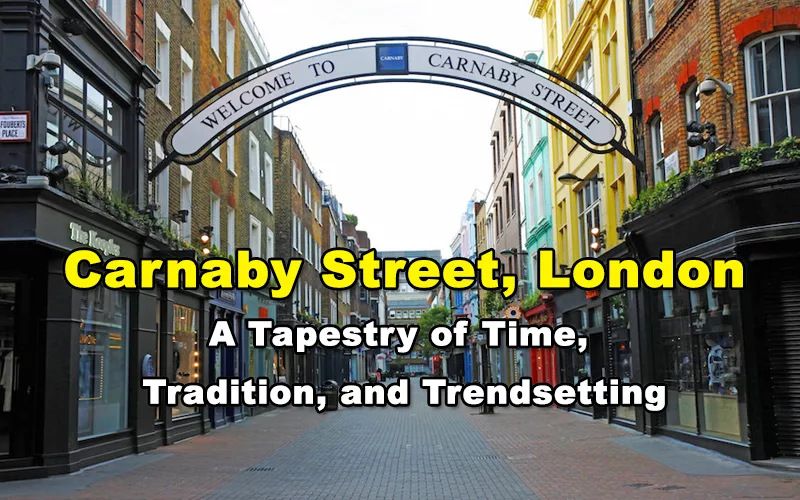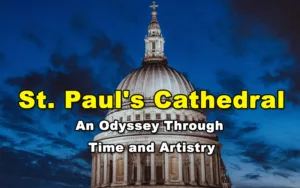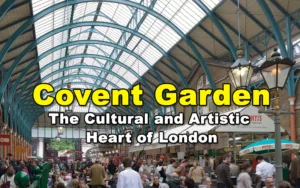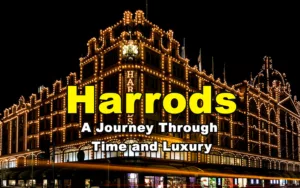Nestled in the heart of London, Carnaby Street stands as a timeless symbol of culture, history, and above all, fashion. Originating in the late 17th century and spanning a mere 200 meters, this pedestrianized shopping street became globally recognized during the swinging sixties, showcasing an eclectic mix of vibrant colours, innovative designs, and unbridled youthful energy. Carnaby Street was not merely a shopping destination; it was the pulsating heart of a fashion revolution, where the classic met the contemporary, sculpting an era that defined generations.
The influence of Carnaby Street permeates far beyond its geographical limitations. During the 1960s, it became an emblematic locale that mirrored societal changes and boldly showcased emerging trends. It was where the “Mod” and “Hippie” cultures found a home, coexisting and shaping an unparalleled fashion and cultural epoch.
Iconic figures like The Beatles, The Rolling Stones, and fashion designer Mary Quant were all woven into the fabric of Carnaby’s rich history, solidifying its status as a cultural and social epicentre. Even today, the street retains its status, bridging the storied past with a dynamically evolving present, offering a distinctive blend of cutting-edge fashion, diverse cuisine, and a tangible spirit of rebellion and innovation.
Navigating through the vibrant lanes of Carnaby Street, this article seeks to embark on a journey that entwines the past with the present, exploring its historical roots, cultural significance, architectural aesthetics, and evolving role in global fashion and culture.
Delving into the experiences from the hedonistic 1960s through to the diversified offerings of modern-day Carnaby, the narrative will weave through various facets of this iconic locale, from its impact on pop culture to its transformative journey amidst the shifting sands of time.
Join us as we traverse through the tales of fashion rebellion, cultural shifts, and a timeless legacy that Carnaby Street has unassumingly shouldered through the centuries, promising not just a physical journey, but an immersive expedition into a rich and colourful history.
- Historical Overview of Carnaby Street
- Architectural Aesthetics of Carnaby Street
- Cultural and Fashion Significance of Carnaby Street
- The Swinging Sixties And Carnaby Street
- A Diverse Culinary Scene In Carnaby Street
- Modern-Day Carnaby Street
- Carnaby Street and Pop Culture
- Navigating Through Carnaby Street
- Summing Up Carnaby Street
Historical Overview of Carnaby Street
Origin and Development of Carnaby Street
Carnaby Street, originating in the Bohemian heart of London’s West End, is more than just a stretch of shopping outlets; it is an emblem of historical evolution that has witnessed the winds of change through the centuries. In the late 17th century, Carnaby Street was born, albeit not with the flamboyant identity that it would later assume.
Initially a residential area, it witnessed incremental shifts through the 18th and 19th centuries, gradually becoming an industrial and commercial hub. It was in the mid-20th century, however, that Carnaby Street truly began to sew its seeds into the colourful quilt of London’s culture, intertwining itself into the vivacious life threads of the city.
The Mod Movement and the 1960s Fashion Revolution
Stepping into the 1960s, Carnaby Street became synonymous with a burgeoning fashion rebellion, becoming the cradle of the “Mod” (Modernist) movement. This youth-driven cultural phenomenon was characterized by its unique blend of tailored suits, bold prints, and a fervent appetite for newness and rebellion against the conventional.
John Stephen, known as “The King of Carnaby Street”, was among the pioneers who redefined men’s fashion, aligning it with the exuberant, optimistic spirit of the time. Simultaneously, designers like Mary Quant were breaking molds in women’s fashion, introducing miniskirts and hot pants, igniting a revolution that sought to liberate and empower through fashion. The street burgeoned as a flamboyant spectacle, illuminating the landscape with a daring vibrancy that hadn’t been witnessed before.
Influence on British Culture and International Fashion
Carnaby Street not only shaped but was shaped by, the cultural and social developments of its time, and its influence reverberated through British society and beyond. It wasn’t merely a market; it was a vibrant canvas where art, culture, politics, and social change converged and dialogued through the medium of fashion. Carnaby Street’s cultural aftershocks were felt worldwide.
From the threads of its vibrant boutiques, it weaved into the fabric of international fashion, guiding it towards a path that was more expressive, fearless, and unapologetically authentic. A hub of ideas and innovations, it seduced international designers, celebrities, and everyday tourists, all drawn by the lure of its eclectic spirit, thus embedding British fashion and culture into the global zeitgeist.
In the annals of history, Carnaby Street is immortalized not merely as a physical locale but as a living, breathing entity that dialogued with, responded to, and helped shape the epoch in which it thrived. Its influence permeates through time, whispering tales of past rebellions, innovations, and an undying spirit that promises to pulse through its vibrant lanes for centuries to come.
Architectural Aesthetics of Carnaby Street
Description of the Characteristic Buildings and Design
Embarking on a journey down Carnaby Street is like stepping into a unique architectural tapestry that seamlessly melds the old with the new. The buildings lining this historic street are quintessentially British yet pulsate with a youthful, eclectic energy that mirrors its vibrant past.
Characterized by vibrant facades, ornate Victorian structures, and playful, modern motifs, the buildings are far more than mere physical entities; they are silent narrators of a rich, varied history. Elegant bow windows, cobblestone pathways, and the flamboyant signage of shops create a visage that is both charming and contemporary, offering a visual treat that is inherently ‘Carnaby.’
Significance of the Area’s Architecture
Carnaby Street’s architecture stands as a tangible reflection of its historical and cultural lineage, offering a physical embodiment of the various eras it has transcended. The structures tell tales of times gone by, from the regality of Victorian England to the rebellious, dynamic energy of the swinging sixties.
This architectural melange not only adds to the aesthetic appeal of the area but also serves as a perpetual reminder of London’s ability to harmoniously blend tradition with modernity. Moreover, the area’s architecture has played a crucial role in shaping its identity as a fashionable, innovative, and culturally rich locale, attracting designers, artists, and entrepreneurs who have continually infused it with a rejuvenating spirit.
Conservation and Renovation Efforts
Preserving the physical essence of Carnaby Street while ensuring its evolution in tandem with contemporary times has been an ongoing endeavour. Various conservation and renovation efforts have been undertaken to maintain the historic integrity of the buildings while infusing them with modern amenities and features.
The architectural conservation is not merely focused on maintaining a static image of the past but seeks to allow the buildings to evolve while retaining their foundational historical and aesthetic essence. The renovated facades, though drenched in modernity, still whisper tales of the past, ensuring that every brick, window, and cobblestone remains an integral thread in the vibrant tapestry that is Carnaby Street.
In traversing through the architectural lanes of Carnaby Street, one navigates through a visual narrative that is both historically rich and contemporarily relevant. This historical aesthetic plays a pivotal role in defining the street’s unique charm, drawing visitors into a world where every building tells a story, every façade is a piece of art, and every step forward is a step back into the rich, vibrant annals of its past.
Cultural and Fashion Significance of Carnaby Street
Carnaby Street as a Symbol of London’s Fashion Scene
Carnaby Street has long been hailed as the pulsating heartbeat of London’s vibrant fashion scene. From its transformative 1960s era to the present day, it has symbolized more than mere style; it has stood as an epitome of cultural expressions, aspirations, and rebellious energies of generations.
The street has not just followed, but often led the zeitgeist, emerging as a focal point where socio-cultural movements and fashion intertwine. Carnaby has championed the unconventional, becoming a canvas where new norms were, and continue to be, fearlessly forged, marking itself as a perpetual symbol of London’s eclectic and dynamic fashion sphere.
Notable Designers, Boutiques, and Trends Originating from Carnaby Street
The prominence of Carnaby Street in the fashion world can be largely attributed to the designers and boutiques that chose it as the stage to showcase their revolutionary ideas. Iconic figures such as Mary Quant, who redefined femininity with the introduction of the mini-skirt, and John Stephen, who clothed countless stars and was pivotal in defining the mod style, have left an indelible mark.
Numerous trends, from the bold patterns and bright colours of the 60s, to the punk influences that permeated the 70s and 80s, have their roots firmly planted in the boutiques of Carnaby Street. This trendsetting legacy has cascaded through the decades, ensuring Carnaby’s continual influence in shaping global fashion narratives.
Current Status as a Fashion Hotspot and Tourist Attraction
Carnaby Street continues to be a magnet for fashion enthusiasts, tourists, and those looking to drink in the aura of a location steeped in cultural history and stylistic innovation. Boasting an array of boutiques that span high-end brands to independent designers, it is a thriving hub that attracts a global clientele and a place where emerging designers find a platform.
Furthermore, its cultural and historical significance makes it a must-visit location for tourists, allowing them to step into a world where every corner whispers tales of cultural revolutions, iconic figures, and epochs shaped by innovative designs and ideas.
Carnaby Street has transcended its physical boundaries to become a symbol of cultural and fashion revolutions, where past, present, and future interweave to create a tapestry that is vivid, dynamic, and eternally significant. Its legacy is not merely confined to its historical impact but is perpetually being redefined by the vibrant energies, inventive designs, and cultural expressions that continue to pulsate through its charismatic avenues.
The Swinging Sixties And Carnaby Street
Description and Impact of the “Swinging London” Phenomenon
The 1960s heralded a new era of cultural, social, and artistic rejuvenation, fondly termed as the “Swinging Sixties”. London, with Carnaby Street at its epicentre, became the global hotspot for youth-driven movements, pushing boundaries and redefining norms.
The term “Swinging London” encapsulated an epoch where the city thrummed with an unprecedented energy, characterized by innovative music, avant-garde fashion, radical art forms, and a general sense of optimism and liberation.
This phenomenon reshaped not just the physical landscape of London but also the mindset of a generation, as the world watched and often followed suit. Carnaby Street, bustling with activity, became the physical manifestation of this transformative movement, offering a space where individuality, creativity, and rebellion were not just accepted, but celebrated.
Iconic Figures Associated with Carnaby Street (e.g., The Beatles, Mary Quant)
Numerous luminaries of the era, both from the music and fashion world, frequented, celebrated, and were inextricably linked with Carnaby Street. The Beatles, with their revolutionary sound and style, often frequented its boutiques, further amplifying the street’s fame.
Their influence, combined with that of other music legends like The Rolling Stones, made Carnaby a nexus for the musical and the fashionable to converge. Similarly, designers like Mary Quant, with her ground-breaking designs like the mini-skirt, not only established boutiques here but also championed the spirit of the street, marrying fashion with cultural revolution. These iconic figures, amongst many others, amplified Carnaby Street’s significance, making it the melting pot of ideas, innovations, and revolutionary expressions.
Enduring Legacy of the 1960s Era
The ripples of the Swinging Sixties, with Carnaby Street at its heart, continue to be felt even today. While the era itself was transient, its legacy is enduring. The cultural freedom, the audacity to challenge the status quo, and the blend of fashion with socio-political expressions from the 1960s have paved the way for subsequent movements and trends.
The street remains emblematic of a time when boundaries were pushed, conventions were challenged, and a new, vibrant world was envisaged. The ethos of the sixties continues to inspire designers, musicians, and artists, ensuring that the spirit of the era remains alive, not just as nostalgic reminiscence, but as a continual source of inspiration and rejuvenation.
In the annals of Carnaby Street’s history, the Swinging Sixties was not merely a decade but a defining moment that sculpted its identity. While the street has witnessed numerous phases, the sixties remains one of its most iconic epochs, a time when Carnaby was not just a street in London but the epicentre of a global cultural revolution.
A Diverse Culinary Scene In Carnaby Street
Exploration of Cafes, Restaurants, and Pubs in the Area
Embarking upon a gastronomic journey through Carnaby Street opens up a world where traditional British fare coexists harmoniously with a myriad of international cuisines. From quaint cafes that serve aromatic coffees paired with freshly baked pastries, to upscale restaurants offering gourmet dining experiences, Carnaby Street provides a culinary canvas that satisfies diverse palate preferences.
Not to be overlooked, the cozy pubs along and around the street, with their rich ales and hearty meals, stand as gateways to experiencing British pub culture, providing not just sustenance but a warm, inviting atmosphere that has been a staple in London’s social scene for centuries.
Influence of International Cuisines
London, being a cosmopolitan city, has embraced flavours from across the globe, and Carnaby Street stands as a testament to this culinary diversity. As you saunter along, you’ll encounter a tapestry of international cuisines – from the aromatic spices of Indian curries to the bold and vibrant flavours of Mexican fare, the refined and delicate tastes of Japanese sushi to the rich and hearty dishes of Italian kitchens.
This rich culinary mosaic not only reflects the multicultural fabric of London’s population but also underscores Carnaby Street’s open, inclusive, and innovative spirit, where various cultures are celebrated and integrated into its very essence.
Popular Dishes and Where to Find Them
Navigating through Carnaby’s culinary scene allows one to explore a plethora of dishes, each with its own story and flavour profile. For those seeking traditional British dishes, classic Fish and Chips can be found in eateries that resonate with an old-world charm.
Those wishing to explore beyond the British Isles may find solace in the comforting warmth of Italian pasta, the spicy allure of Thai curries, or the subtle complexity of French cuisine, each served in various establishments that dot the street and its surrounding areas. Additionally, numerous vegan and vegetarian options reflect a modern, health-conscious and ethical dining trend, providing ample choices for individuals of varied dietary preferences.
Within Carnaby Street, every café, restaurant, and pub serves not just as a provider of nourishment but as a miniature world where flavours tell tales of diverse cultures, traditions, and histories. Here, dining transcends mere consumption, morphing into an immersive experience that reflects the multicultural, vibrant, and ever-evolving ethos of Carnaby Street itself.
Modern-Day Carnaby Street
Evolution and Adaptation to Contemporary Fashion Trends
Modern-day Carnaby Street stands as a testimony to an ongoing evolution, one that respects its illustrious past while boldly stepping into the present and future. It has maintained its reputation as a trendsetting locale, seamlessly incorporating contemporary fashion trends and emerging as a pivotal platform for young, innovative designers.
The street has witnessed a shift from the starkly rebellious styles of the swinging sixties towards an inclusive space that accommodates myriad fashion narratives – from high-end luxury to sustainable fashion, vintage shops to cutting-edge modern boutiques. This continual evolution ensures that Carnaby remains not just relevant but a vibrant, influential player in London’s fashion scene.
Carnaby Street Events, Festivals, and Celebrations (e.g., Carnaby Street Christmas Lights)
The magnetic energy of Carnaby Street further amplifies during its numerous events, festivals, and celebrations, which are integral to its modern-day charm and appeal. A standout amongst these is the enchanting display of the Carnaby Street Christmas Lights, an annual spectacle that transforms the street into a whimsical wonderland, drawing visitors from across the globe.
Other events such as fashion shows, music festivals, and cultural celebrations further animate the street, ensuring it pulses with a continuous, dynamic energy. These events not only elevate the visitor experience but also fortify Carnaby Street’s reputation as a locale where fashion, culture, and celebration converge in a spectacularly vibrant manner.
Present-day Shopping and Dining Experience
Today’s Carnaby Street offers a shopping and dining experience that is both richly diverse and distinctly unique. Visitors can explore an array of shops, from iconic brands to independent boutiques, each providing a different shade to the overall retail palette.
The dining experience, as well, caters to a spectrum of preferences, offering everything from quick, casual bites to luxurious, fine-dining experiences. This combination of diverse retail and culinary options, set against the backdrop of Carnaby’s historic and cultural significance, provides a multifaceted experience that goes beyond mere consumption, allowing visitors to immerse themselves in an environment that is at once historically rich and contemporarily vibrant.
In navigating through the bustling avenues of modern-day Carnaby Street, one encounters a world that is as dynamically current as it is nostalgically retrospective. Its ability to continually evolve, whilst respecting and incorporating its rich history, renders it a location that is not just survived but thrived through the ages, promising a future that is as vibrant and dynamic as its past.
Carnaby Street and Pop Culture
Reflection in Music, Films, and Literature
Carnaby Street’s vibrant spirit and influential history have permeated various facets of pop culture, leaving indelible imprints in music, films, and literature. Songs penned in its honour, such as “Carnaby Street” by The Jam, capture its energetic vibe and historical significance.
Films and documentaries have utilized the street as a backdrop to narrate stories of the cultural and fashion revolutions that it spearheaded. Moreover, literature has embraced Carnaby Street, often referencing it as a symbol of rebellion, innovation, and the effervescent youth culture of the 1960s. These representations across various media facets have echoed and amplified the cultural impact of the street globally.
Pop Culture Icons and Their Association with Carnaby Street
Iconic figures from the worlds of music, fashion, and art have traversed the pulsating pathways of Carnaby Street, embedding it further into the global pop culture psyche. Notable personalities like The Beatles, The Rolling Stones, Jimi Hendrix, and numerous others have sauntered through its avenues, shopped in its boutiques, and often identified with its vibrant, rebellious spirit.
Fashion icons such as Mary Quant and Twiggy have also been integral to its global recognition, embodying the innovative and audacious spirit of the street. These associations have not only solidified Carnaby Street’s status within pop culture but have also facilitated a symbiotic relationship where the icons and the street mutually enhanced each other’s legacies.
Impact on Global Cultural Scenarios
The impact of Carnaby Street transcends its geographical confines, influencing global cultural scenarios and often being synonymized with London’s—and by extension, Britain’s—fashion and cultural identity. Its contribution to the ‘Swinging Sixties’ was not confined to the UK but reverberated across continents, influencing styles, norms, and cultural narratives worldwide.
Carnaby became a symbol, an idea that encapsulated innovation, liberation, and a breaking away from the conventional, inspiring similar movements and trends in various global locales. Its influence can be witnessed in the international adoption of mod style, the global resonance of British pop culture, and the universal narratives of youth rebellion and cultural innovation that it helped mold.
Carnaby Street stands as a cultural landmark, its name echoing tales of revolutions, innovations, and an undying spirit that has been celebrated and immortalized in various pop culture avenues. It doesn’t just remain a physical location but transforms into a cultural emblem, woven into the global tapestry of music, fashion, and rebellious fervour, continuing to inspire and be revered by generations across the world.
Navigating Through Carnaby Street
Guide to Visiting (Getting There, Best Times to Visit, etc.)
Exploring Carnaby Street, located in the bustling heart of London’s West End, is an excursion into a vibrant world where history and modernity dance in harmonious interplay. Visitors can easily access this iconic street via multiple transport links; the nearest Tube stations include Oxford Circus and Piccadilly Circus, making it conveniently accessible.
Carnaby is vibrant year-round; however, visiting during special events or festivals, like during the unveiling of the renowned Christmas lights, provides an enhanced, festive experience. The spring and summer months also offer a pleasant ambience for leisurely strolls, al fresco dining, and soaking in the lively atmosphere.
Noteworthy Spots and Hidden Gems
While Carnaby is famed for its shopping and dining, there are various noteworthy spots and hidden gems that enrich any visit. Kingly Court, a three-story dining hub, is a must-visit for gastronomy lovers, providing a wide array of culinary options.
The Newburgh Quarter offers an eclectic mix of bespoke shops and indie boutiques, providing a quieter, alternative shopping experience. Carnaby Street’s surroundings are also studded with numerous historical landmarks and lesser-known gems such as themed bars, secret gardens, and small galleries that provide an intimate, off-the-beaten-path exploration of the area.
Tips for Tourists and Locals Alike
1. Embrace Exploration: Carnaby invites wanderers to explore its every nook and cranny. While the main street is an experience in itself, the adjacent lanes and courtyards hold a treasure trove of experiences.
2. Check the Calendar: Prioritize checking the event calendar on the official Carnaby website to coincide your visit with unique events, launches, or celebrations that provide an extra layer of excitement.
3. Shopping Smart: With an abundance of shopping options, it’s wise to explore both flagship stores and independent boutiques to get a wholesome retail experience. Don’t forget to check for seasonal sales or special discounts!
4. Dining Decisions: Whether opting for a quick snack, a casual meal, or a fine-dining experience, ensure to explore diverse culinary options, perhaps even trying something new and unexpected.
5. Footwear Wisdom: Given that the best way to explore Carnaby is on foot, comfortable footwear is crucial to fully enjoy the wandering, shopping, and exploring without weary feet.
6. Preserve Memories, Respectfully: While capturing memories through photos is a given, being mindful of shop rules and respecting privacy keeps the experience pleasant for all.
7. Local Interaction: Engaging with local shopkeepers, artists, and restaurateurs not only provides insight into the true spirit of Carnaby but also often reveals insider tips and recommendations.
Navigating through Carnaby Street, with its rich tapestry of experiences, ensures every visit is unique, and every wanderer, whether a tourist or a seasoned local, discovers something new, exciting, and refreshingly vibrant within its lively confines.
Summing Up Carnaby Street
Recapitulation of Key Points
Embarking on a journey through Carnaby Street invites explorers into a world where historical epochs and modern vitality converge in a vivacious meld. From its historical roots, encapsulating its foundational development and vital role during the Swinging Sixties, to its indelible mark on the global fashion and cultural spheres, Carnaby Street epitomizes a dynamic intersection of the past, present, and future.
The diverse architectural aesthetics, its significance as a culinary haven, and its reflective portrayal in pop culture further underline its multi-faceted identity. Finally, envisioning its future, it is apparent that Carnaby Street is not merely a physical locale but a perpetually evolving narrative that seamlessly intertwines tradition and innovation.
Personal Reflection on the Cultural Importance of Carnaby Street
Carnaby Street, beyond its tangible aspects, personifies a spirit of rebellion, creativity, and cultural progression. It’s a tangible manifestation of a zeitgeist that has consistently pushed boundaries and embraced evolutions, becoming a symbol of a city that is unafraid to redefine itself while honouring its roots.
Its cultural importance is mirrored not just in its contribution to fashion, music, and societal shifts but also in its implicit ethos that encourages expressive freedom, inclusivity, and bold creativity. This haven provides an immersive cultural tapestry where every strand, from its cobbled paths to its neon lights, narrates tales of icons, revolutions, and timeless style.
Final Thoughts on its Sustained Significance in London’s Identity
As a microcosm of London’s broader cultural, historical, and innovative landscape, Carnaby Street perpetually enthrals both the casual wanderer and the dedicated historian. Its sustained significance in London’s identity can be attributed to its capacity to continuously reinvent itself while safeguarding its historical essence, thus providing a stable, yet ever-fresh, presence in the city’s heartbeat.
As we gaze towards the future, the street is poised to continue being a pivotal axis around which London’s cultural, fashion, and social narratives gracefully revolve. It shall persist as a luminous thread in the city’s vibrant tapestry, gleaming with stories, trends, and an undying, spirited energy that has, and will continue to, captivate generations.
“I may earn commissions as an affiliate from sponsored links within this post”








